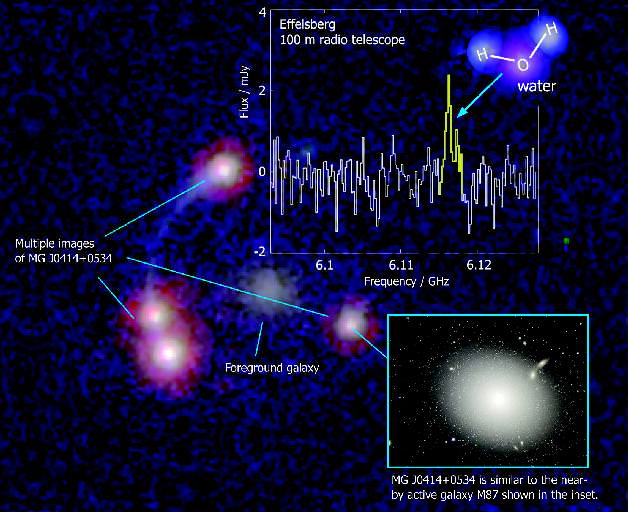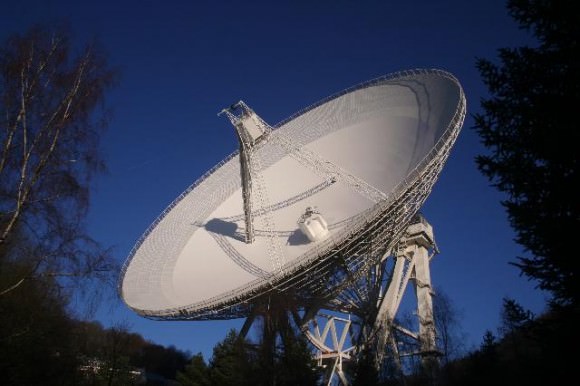[/caption] A long time ago in a galaxy far, far away there was water. Astronomers have found tell-tale signatures of water molecules in a galaxy more than 11 billion light years from Earth. Using the giant, 100-meter-diameter radio telescope in Effelsberg, Germany, along with the Very Large Array (VLA) in New Mexico, scientists detected the most distant water yet seen in the Universe. Previously, the most distant water had been seen in a galaxy less than 7 billion light-years from Earth. Since it is so far away, we're actually seeing it as it was long ago; as when the Universe was one-sixth the age it is now. The astronomers were able to take advantage of two types of natural "amplification" to detect the water in this galaxy. The galaxy, dubbed MG J0414+0534 has a quasar -- a supermassive black hole powering bright emission -- at its core. In the region near the core, the water molecules are acting as masers, the radio equivalent of lasers, to amplify radio waves at a specific frequency. Additionally, another galaxy was used as a gravitational lens to magnify the radio signals used to detect the water molecules.
The astronomers say their discovery indicates that such giant water masers were more common in the early Universe than they are today. At the galaxy's great distance, even the strengthening of the radio waves done by the masers would not by itself have made them strong enough to detect with the radio telescopes.
With the help of gravitational lensing from another galaxy, nearly 8 billion light-years away, located directly in the line of sight from MG J0414+0534 to Earth, the foreground galaxy's gravity served as a lens to further brighten the more-distant galaxy and make the emission from the water molecules visible to the radio telescopes. [caption id="attachment_22444" align="aligncenter" width="580" caption="Effelsberg Telescope."]
[/caption] The astronomers first detected the water signal with the Effelsberg telescope. They then turned to the VLA's sharper imaging capability to confirm that it was indeed coming from the distant galaxy. The gravitational lens produces not one, but four images of MG J0414+0534 as seen from Earth. Using the VLA, the scientists found the specific frequency attributable to the water masers in the two brightest of the four lensed images.
The radio frequency emitted by the water molecules was Doppler shifted by the expansion of the Universe from 22.2 GHz to 6.1 GHz.
"We were only able to discover this distant water with the help of the gravitational lens," said Violette Impellizzeri, an astronomer with the Max-Planck Institute for Radioastronomy (MPIfR) in Bonn, Germany. "This cosmic telescope reduced the amount of time needed to detect the water by a factor of about 1,000," she added.
Water masers have been found in numerous galaxies at closer distances. Typically, they are thought to arise in disks of molecules closely orbiting a supermassive black hole at the galaxy's core. The amplified radio emission is more often observed when the orbiting disk is seen nearly edge-on. However, the astronomers said MG J0414+0534 is oriented with the disk almost face-on as seen from Earth.
"This may mean that the water molecules in the masers we're seeing are not in the disk, but in the superfast jets of material being ejected by the gravitational power of the black hole," explained John McKean, also of MPIfR.
The team's paper will be published in the Dec. 18 edition of Nature.
- Source
-
NRAO
 Universe Today
Universe Today

